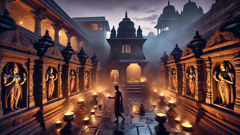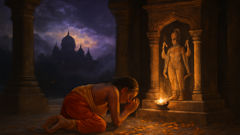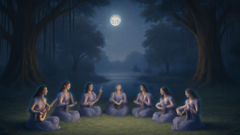Introduction
In the heartland of Central Java, where lush volcanic plains stretch beneath a brooding sky, there rises a magnificent silhouette of stone: the Prambanan temple complex. Soaring spires pierce the misty dawn, their reliefs etched with stories of gods, demons, and mortals who once walked the land. Yet among these stones lies a tale deeper than any carved inscription—a story whispered on the wind and carried through generations by the people of Java. This is the legend of Roro Jonggrang, a princess of incomparable beauty and fierce spirit, whose fate became inseparable from the ancient stones that still captivate travelers and worshippers today. Long before the temples graced the horizon, two mighty kingdoms—Prambanan and Pengging—vied for supremacy. War raged, heroes fell, and the world trembled beneath their struggle. Amid this chaos, love bloomed and withered, dreams twisted into curses, and the impossible became reality under the shadow of longing and revenge. From the forests shrouded in morning haze to the palaces flickering with candlelight, the legend weaves together threads of romance and magic, ambition and heartache. Every stone in Prambanan is said to hold a secret; every relief, a memory. And at the heart of it all stands the figure of Roro Jonggrang herself—her story immortalized not only in legend but in the very foundation of Java’s most breathtaking monument.
Kingdoms at War: The Meeting of Fates
Long ago, Java was ruled by rival kingdoms whose ambitions shaped the fate of the island. Prambanan, with its golden palaces and fertile lands, was ruled by King Boko, a man whose might was matched only by his pride. To the north, the kingdom of Pengging was led by the wise but restless King Damar Maya, whose son Bandung Bondowoso was famed for his valor and command of supernatural forces. The peace between them was fragile—a glass bridge stretched across a chasm of suspicion. When King Boko’s greed drove him to march against Pengging, war engulfed the land. The air rang with the clash of steel, and the fields were scarred by fire. The bravest among King Boko’s generals was none other than his daughter, Roro Jonggrang. Though celebrated for her beauty, she was no mere ornament at court; she trained with warriors, studied statecraft, and cared for her people. Her resolve was steel, her gaze unflinching.
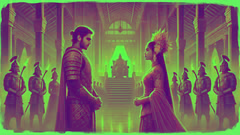
After months of brutal fighting, King Boko fell on the battlefield. His armies scattered, and Prambanan’s proud banners were trampled into mud. Roro Jonggrang mourned her father but did not yield. She rallied the survivors behind her, vowing to protect her people from further suffering. Yet the victors soon arrived at Prambanan’s gates—led by Bandung Bondowoso himself, his eyes burning with ambition and longing. He expected a queen cowering behind stone walls, but found instead a princess standing tall, her head crowned with defiance.
Bandung Bondowoso was awestruck. The tales of Roro Jonggrang’s beauty had not been exaggerated, but none had captured the quiet ferocity of her spirit. In her presence, his warlike heart faltered. He spoke to her not as a conqueror but as a suitor, declaring his wish to marry her and rule Prambanan in peace. The proposal spread through the court like wildfire—some saw it as salvation, others as humiliation. Roro Jonggrang herself was torn. She despised the man who had vanquished her father, but she also understood the cost of continued resistance. Bound by duty, she weighed the fate of her people against her own desires.
To buy time, Roro Jonggrang set forth an impossible demand: “If you wish to take my hand, build me a thousand temples in a single night. Only then will I be yours.” She believed this task could never be completed, for even the gods would struggle to create such splendor before dawn. Yet Bandung Bondowoso smiled, undaunted. With a voice as steady as stone, he accepted the challenge. As the last light faded from the sky, he called upon his mystical powers, summoning spirits and demons to bend time and earth to his will.
As darkness cloaked the land, an army of supernatural beings swept across the plain. Stones flew, carvings took shape, and temple after temple rose from the soil, their spires glowing under the ghostly moon. Roro Jonggrang watched from her chamber, dread prickling her skin. She had underestimated her suitor. The night wore on, and with each completed temple, hope slipped further away. Yet she refused to yield to despair. As the thousandth temple neared completion, a plan formed in her mind—a final gamble to outwit fate itself.
A Night of Sorcery and Deception
The hours slipped away as supernatural hands built temples at an unimaginable pace. Each stone locked into place with a sound that echoed across the valley, while the wind hummed with the energy of ancient incantations. From her window, Roro Jonggrang watched the procession of spirits, her heart pounding with fear and urgency. The moon hung high above the fields, casting an ethereal glow on the half-finished towers and the shadowy figures toiling below.
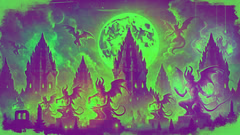
Desperation gave birth to courage. Roro Jonggrang summoned her most trusted maidservants and whispered her scheme. “Gather straw from the fields and mortars from the kitchens. We must trick the spirits into believing dawn has arrived.” Silently, they slipped into the darkness, spreading straw near the eastern gates and lighting fires that blazed against the night. Others pounded rice in the mortars, sending rhythmic echoes through the pre-dawn air—a sound that usually signaled the day’s beginning in Javanese villages.
The supernatural workers paused. They looked to the east and saw flames licking the horizon. The sound of pounding rice mingled with the crowing of roosters, for Roro Jonggrang’s servants had roused them from their slumber. The spirits recoiled in confusion and dread; dawn meant their labors must cease. In a panic, they abandoned their posts, fleeing into the mist as the first faint rays of sunlight appeared.
Bandung Bondowoso arrived to inspect his work, triumphant at having completed nine hundred and ninety-nine temples. Yet as he prepared to lay the final stone, he saw that his helpers had vanished. The spell had been broken—the task incomplete. His gaze fell upon Roro Jonggrang, who stood on the terrace with an expression of feigned innocence. Anger flared within him as he pieced together the deception. “You have betrayed our bargain!” he thundered. “You have tricked me and mocked the sacred promise!”
But Roro Jonggrang met his rage with unwavering composure. “You sought to win my hand by magic and not by heart. I am not a prize to be won with tricks and curses.” Her words rang clear and proud, echoing through the palace’s marble halls. For a moment, time itself seemed to freeze—the two adversaries locked in a silent duel of wills and wounded pride. Then Bandung Bondowoso’s fury twisted into something colder, deeper. Spurned and humiliated, he raised his hands and called upon his powers one final time. With a curse that trembled the ground, he transformed Roro Jonggrang into stone—a statue to complete the thousandth temple and stand forever as a reminder of love lost to pride and betrayal.
To this day, visitors to Prambanan temple find a statue of a beautiful maiden in the main chamber, her features elegant yet tinged with sorrow. Locals say it is Roro Jonggrang herself, destined to gaze out over the temples she inspired—an eternal witness to the legend that shaped Java’s heart.
Conclusion
The legend of Roro Jonggrang is more than a tale of love and revenge; it’s a living memory etched into Java’s soul. Every stone at Prambanan, every carved relief and silent corridor, resonates with echoes of her story. Pilgrims and travelers alike wander the temple grounds, pausing before the statue of the maiden whose fate was bound to ambition and heartbreak. Some whisper prayers for forgiveness, others leave offerings of jasmine or betel as tokens of remembrance. The story endures not only because of its magic, but because it speaks to something universal—the struggle between heart and duty, the cost of pride, and the enduring power of hope. Though Bandung Bondowoso’s curse turned Roro Jonggrang to stone, her spirit remains unbroken, watching over the land she loved. Through triumph and tragedy, her legend has shaped the very heart of Java, teaching generations that even in sorrow, beauty and meaning can be found. So as the sun sets behind Prambanan’s towers, the stones themselves seem to breathe, holding close the secrets of a princess who outwitted fate—and became immortal.






